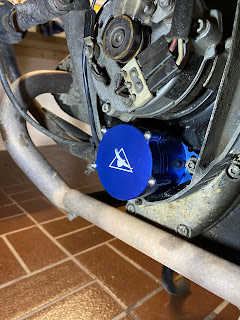In September 2019 I purchased a second R65LS, broadly identical to the first: both red, both with Brembo brakes, both with stainless exhausts, but 1984 rather than 1983 and only 135,000km on the clock. It looked like a good deal, purchased from the mechanic who had maintained it for the last 20 years. It arrived on the back of a truck looking as good as it had in the pictures. 1983 on left, 1984 on right.

When I went to get it registered the problems started, and they have only recently been properly ironed out.
First problem was that it wouldn't rev above 4,000 rpm. There were lots of little problems with the carbs, each time I'd reassemble them and hope that the latest minor fix had resolved the problem, but eventually I did a full rebuild. It turned out that the seller's idea of "recently rebuilt carburettors" didn't involve replacing all the O rings or cleaning the main jet holder. Weirdly they had assembled one of the diaphragms rotated: it's surprising that the bike could be tuned at all.
The image shows that the piston is rotated (the diaphragm is located correctly in the carb body, the problem is that it has been fitted to the piston rotated).
Riding on the freeway a vibration was setup that suggested a failing wheel bearing, but when I pulled off the road the rear brake came on and locked in place. I'd noticed that the gearshift was in unusually good condition for such an old bike, it had been replaced and somehow part of the original had fallen into the housing of the rear brake pedal, jamming it on.
Always find the bit you drop!
The engine note changed and then the exhaust flange nut on the LHS cylinder came loose: it had been held on only by one thread and a stack of grease. This was sleeved and rethreaded by an engineer.
The pin put through the sleeve to the cylinder head is just visible.
The carburettors were now running but difficult to balance. I had some holes in the header pipes welded over to fix this.
Keeping two identical bikes is a bit odd, but there are lots of advantages. Obviously I can ride one while the other is off the road for maintenance. And I can swap components to troubleshoot. I have little experience maintaining bikes apart from airhead BMWs, and all my skills are easily transferred between the two LSs.
I'm now to the point I expected to be a month after the purchase: two bikes, either of which I'd trust to go riding.


















